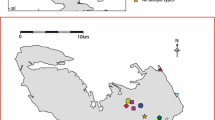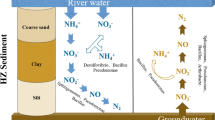Abstract
The dynamics of organic carbon (OC), turbidity, faecal indicator bacteria and physicochemical parameters was studied in a karst system near Yverdon, Switzerland. Online measurements and sampling were done at a swallow hole draining an agricultural surface (the input), and two groups of springs (the outputs) that often show bacterial contamination. A fluorescent tracer that was injected into the swallow hole during low-flow conditions first arrived at the springs 10–12 days after injection; the total recovery rate was 29%. Previous tracer tests during high-flow conditions gave shorter travel times. After a major rainfall event, a primary turbidity peak was observed at the springs. It coincides with the rising limb of the hydrograph, indicating remobilisation of autochthonous particles from the aquifer. A secondary turbidity peak occurs several days later, suggesting the arrival of allochthonous particles from the swallow hole. Wider peaks of OC and bacteria were observed simultaneously. Applying methods from molecular microbiology (PCR-DGGE) allowed characterisation of the bacterial communities at the swallow hole and the springs. The results demonstrate that the swallow hole is an important source of groundwater contamination, while its contribution to aquifer recharge is insignificant. OC appears to be a better indicator for bacterial contamination than turbidity.
Résumé
La dynamique du carbone organique, de la turbidité, des bactéries indicatrices de contamination fécale et d’autres paramètres physico-chimiques a été étudiée dans un système karstique proche de la ville d’Yverdon-les-Bains, Suisse. Des mesures en continu ainsi que des échantillonnages ont été effectués à une perte drainant une zone agricole (input), et à deux groupes sourciers (output) qui montrent fréquemment une contamination bactérienne. En période d’étiage, un essai de traçage à l’uranine a été réalisé depuis la perte. Le traceur est apparu aux sources 10–12 jours après l’injection; la masse de restitution totale a été de 29%. Des essais précédents, réalisés en hautes eaux, ont montré des temps de transit plus court. Suite à un événement pluvieux important, un pic de turbidité primaire, synchrone avec l’augmentation du débit, est observé aux sources, indiquant une re-mobilisation des sédiments autochtones de l’aquifère. Un pic de turbidité secondaire apparaît quelques jours plus tard aux sources, suggérant l’arrivée de matériel allochtone de la perte. Cette dernière est accompagnée de pics plus larges de carbone organique et des bactéries indicatrices de contamination fécale. La microbiologie moléculaire (PCR-DGGE) a permis la caractérisation des communautés bactériennes de la perte et des sources. Ces résultats démontrent l’importante influence de la perte sur la qualité de l’eau souterraine, alors que sa contribution au débit du système est négligeable. Le carbone organique semble être un meilleur indicateur de la présence de contamination bactérienne que la turbidité.
Resumen
Se ha estudiado la dinámica del carbono orgánico, turbiedad, una bacteria indicadora de fecales, y parámetros fisicoquímicos en un sistema kárstico cerca de Yverdon, Suiza. Se realizaron mediciones en línea y muestreo en un sumidero que drena una superficie agrícola (la entrada), y dos grupos de manantiales (las salidas) que frecuentemente muestran contaminación bacterial. Un trazador fluorescente que se inyectó en el sumidero durante condiciones de flujo bajo arribó en los manantiales por vez primera 10–12 días después de que fue inyectado; el ritmo total de recuperación fue de 29%. Las pruebas de trazadores realizadas con anterioridad bajo condiciones de flujo alto aportaron tiempos de viaje más cortos. Después de una tormenta fuerte se observó un pico de turbiedad primario en los manantiales. El pico coincide con el limbo ascendente del hidrograma indicando remobilización de partículas alóctonas provenientes del acuífero. Un pico de turbiedad secundario ocurre varios días más tarde sugiriendo el arribo de partículas alóctonas provenientes del sumidero. Se observaron simultáneamente picos más amplios de carbono orgánico y bacteria. La aplicación de métodos de microbiología molecular (PCR-DGGE) permitieron caracterizar las comunidades de bacteria en el sumidero y los manantiales. Los resultados demuestran que el sumidero es una fuente importante de contaminación de aguas subterráneas mientras que su contribución a la recarga del acuífero es insignificante. El carbono orgánico parece ser un mejor indicador de contaminación bacterial que la turbiedad.







Similar content being viewed by others
References
Alberic P, Lepiller M (1998) Oxidation of organic matter in a karstic hydrologic unit supplied through stream sinks (Loiret, France). Water Res 32(7):2051–2064
Amraoui F, Razack M, Bouchaou L (2003) Turbidity dynamics in karstic systems. Example of Ribaa and Bittit springs in the Middle Atlas (Morocco). Hydrological Sciences Journal-Journal des Sci Hydrologiques 48(6):971–984
Atkinson TC, Smith DI, Lavis JJ, Whitaker RJ (1973) Experiments in tracing underground waters in limestones. J Hydrol 19(4):323–349
Atteia O (1998) Evolution of size distributions of natural particles during aggregation: modelling versus field results. Coll Surf A -Physicochem Engin Asp 139(2):171–188
Atteia O, Kozel R (1997) Particle size distributions in waters from a karstic aquifer: from particles to colloids. J Hydrol 201(1-4):102–119
Auckenthaler A, Huggenberger P (2003) Pathogene Mikroorganismen im Grund- und Trinkwasser. Transport - Nachweismethoden - Wassermanagement (Pathogenic microorganisms in groundwater and drinking water. Transport, analytical methods and water management): 196 p.; Birkhäuser
Auckenthaler A, Raso G, Huggenberger P (2002) Particle transport in a karst aquifer: natural and artificial tracer experiments with bacteria, bacteriophages and microspheres. Water Sci Technol 46(3):131–138
Batiot C (2003) Etude expérimentale du cycle du carbone en régions karstiques (Experimental study of the carbon cycle in karst areas). PhD, University of Avignon, France
Batiot C, Emblanch C, Blavoux B (2003) Total Organic Carbon (TOC) and magnesium (Mg2+): two complementary tracers of residence time in karstic systems. Comptes Rendus Geosci 335(2):205–214
Bouchaou L, Mangin A, Chauve P (2002) Turbidity mechanism of water from a karstic spring: example of the Ain Asserdoune spring (Beni Mellal Atlas, Morocco). J Hydrol 265(1–4):34–42
Boyer DG, Pasquarell GC (1999) Agricultural land use impacts on bacterial water quality in a karst groundwater aquifer. J Am Water Resou Assoc 35(2):291–300
Byrd JJ, Xu HS, Colwell RR (1991) Viable but non-culturable bacteria in drinking water. Appl Environ Microbiol 57:875–878
Chapelle FH (2001) Ground-water microbiology and geochemistry. John Wiley & Sons, New York
Cornaton F, Perrochet P (2002). Analytical 1D dual-porosity equivalent solutions to 3D discrete single-continuum models. Application to karstic spring hydrograph modelling. J Hydrolo 262(1–4):165–176
Danielopol DL, Griebler C, Gunatilaka A, Notenboom J (2003) Present state and future prospects for groundwater ecosys-tems. Envir Conserv 30(2):104–130
Drew D, Hötzl H (eds) (1999) Karst Hydrogeology and Human Activities. Impacts, Consequences and Implications—International Contributions to hydrogeology, 20. Balkema, Rotterdam
Emblanch C, Blavoux B, Puig JM, Mudry J (1998) Dissolved organic carbon of infiltration within the autogenic karst hydrosystem. Geophys Res Lett 25(9):1459–1462
Ford D, Williams DW (1989) Karst geomorphology and hydrology. Unwin Hyman, Boston
Goldscheider N (2002) Hydrogeology and Vulnerability of Karst Systems. Examples from the Northern Alps and Swabian Alb. PhD, University of Karlsruhe. Schr Angew Geol Karlsruhe 68:1–236
Gunn J, Tranter J, Perkins J, Hunter C (1998) Sanitary bacterial dynamics in a mixed karst aquifer. In: Leibundgut C, Gunn J, Dassargues A (eds) Karst Hydrology, vol 247, IAHS Publication, pp 61–70
GSchV (1998) Water Protection Ordinance, GSchV, SR 814.201, Swiss Federal Law, Bern
Heuer H, Smalla K (1997) Application of denaturing gradient gel electrophoresis and temperature gradient gel electrophoresis for studying soil microbial communities. In: van Elsas JD, Trevors JT, Wellington EMH (eds) Modern Soil Microbiology. Marcel Dekker, New York, pp 353–374
Jordi HA (1994) Atlas géologique de la Suisse 1:25000, feuille 1203: Yverdon-les-Bains (Swiss geological atlas 1:25000, sheet 1203: Yverdon-les-Bains). Service hydrologique et géologique national, Ittigen
Käss W (1998) Tracing technique in geohydrology. Balkema, Rotterdam
Katz BG, Catches JS, Bullen TD, Michel RL (1998) Changes in the isotopic and chemical composition of ground water resulting from a recharge pulse from a sinking stream. J Hydrol 211(1–4):178–207
Lacroix M, Rodet J, Wang HQ, Masséi N, Dupont JP (2000) Origine des matières en suspension dans un système aquifère karstique: apports de la microgranulométrie (Origin of suspended matter in a karst aquifer system: contribution of microgranulometry). C R Acad Sci Paris, Sciences de la Terre et des Planètes 330(2000):347–354
Mahler BJ, Personne JC, Lods GF, Drogue C (2000) Transport of free and particulate-associated bacteria in karst. J Hydrol 238(3–4):179–193
Massei N, Wang H, Dupont J, Rodet J, Laignel B (2003) Assessment of direct transfer and resuspension of particles during turbid floods at a karstic spring. J Hydrol 275(1–2):109–121
Mikell AT, Smith CL, Richardson JC (1996) Evaluation of media and techniques to enumerate heterotrophic microbes from karst and sand aquifer springs. Microb Ecol 31(2):115–124
Muralt R (1999) Processus hydrogéologiques et hydrochimiques dans les circulations profondes des calcaires du Malm de l’arc jurassien (Hydrogeological and hydrochemical processes in the circulation system in the Malm limestones of the Jurassic belt). PhD, University of Neuchâtel, Switzerland
Muralt R, Vuataz FD, Schonborn G, Sommaruga A, Jenny J (1997) Integration of hydrochemical, geological and geophysical methods for the exploration of a new thermal water resource. Case of Yverdon-les-Bains, foot of the Jura range. Eclogae Geologicae Helvetiae 90(2):179–197
Muyzer G (1999) DGGE/TGGE a method for identifying genes from natural ecosystems. Curr Opin Microbiol 2(3):317–322
Nebbache S, Loquet M, Vinceslas-Akpa M, Feeny V (1997) Turbidity and microorganisms in a karst spring. Europ J Soil Biol 33(2):89–103
Northup DE, Lavoie KH (2001) Geomicrobiology of caves: A review. Geomicrobiol J 18(3):199–222
Ovreas L, Forney L, Daae FL, Torsvik V (1997) Distribution of bacterioplankton in meromictic Lake Saelenvannet, as determined by denaturing gradient gel electrophoresis of PCR-amplified gene fragments coding for 16S rRNA. Appl and Envir Microbiol 63(9):3367–3373
Personne JC, Poty F, Vaute L, Drogue C (1998) Survival, transport and dissemination of Escherichia coli and enterococci in a fissured environment. Study of a flood in a karstic aquifer. J Appl Microbiol 84(3):431–438
Ryan M, Meiman J (1996) An examination of short-term variations in water quality at a karst spring in Kentucky. Groundwater 34(1):23–30
Schnegg PA, Costa R (2003) Tracer tests made easier with field fluorometers. Technical note. Bull Hydrogeol 20 89–91
Simon KS, Gibert J, Petitot P, Laurent R (2001) Spatial and temporal patterns of bacterial density and metabolic activity in a karst aquifer. Archiv für Hydrobiologie 151(1):67–82
Slijepcevic A, Rossi P, Aragno M, Zopfi J. Relationship between environmental factors and community structure of bacterioplankton as revealed by ribosomal 16S DNA and RNA DGGE fingerprints in a holomictic, eutrophic lake. FEMS Microbiol. Ecol. (submitted)
Sommaruga A (1996) Geology of the central Jura and the Molasse Basin: new insight into an evaporite-based foreland fold and thrust belt. PhD, University of Neuchâtel, Switzerland
Sommaruga A (1999) Decollement tectonics in the Jura foreland fold-and-thrust belt. Marine and Petroleum Geology 16(2):111–134
Szewzyk U, Szewzyk R, Manz W, Schleiffer KH (2000) Microbiological safety of drinking water. Annu Rev Microbiol 54:81–127
Theron J, Cloete TE (2000) Molecular techniques for determining microbial diversity and community structure in natural environments. Crit Rev Microbiol 26(1):37–57
Thurman E (1985) Organic chemistry of natural waters. Nijhoff, Junk, Dordrecht
Zwahlen F (ed) (2004) Vulnerability and risk mapping for the protection of carbonate (karst) aquifers, final report (COST action 620). European Commission, Brussels
Acknowledgements
The Energy Service of Yverdon (SEY) funded this study. We are grateful to Claude-Olivier Pelet, Olivier Flückiger and Pierre Siegrist (SEY) for the good cooperation. We thank Dr. Pierre-André Schnegg for his outstanding field fluorometers, Mari-Eve Farine, Vanessa Di Marzo and Ana Slijepceviv for laboratory work, François Bourret for technical support, and our trainee Xavier Drogue for testing the measuring devices. We thank Pierre Gutzwiler (SIGRIST Photometer AG) for the good cooperation, and MeteoSwiss for the precipitation data. We thank the reviewers for their valuable comments, and Dr. David Drew for language corrections. This study was carried out in order to prepare the BEKARST project, subproject KARSTDYN (dynamics of microbial communities, organic carbon and particles in karst groundwater), which is funded by the Swiss National Science Foundation since October 2004 (Project No. 200020-105427)
Author information
Authors and Affiliations
Corresponding author
Rights and permissions
About this article
Cite this article
Pronk, M., Goldscheider, N. & Zopfi, J. Dynamics and interaction of organic carbon, turbidity and bacteria in a karst aquifer system. Hydrogeol J 14, 473–484 (2006). https://doi.org/10.1007/s10040-005-0454-5
Received:
Accepted:
Published:
Issue Date:
DOI: https://doi.org/10.1007/s10040-005-0454-5




